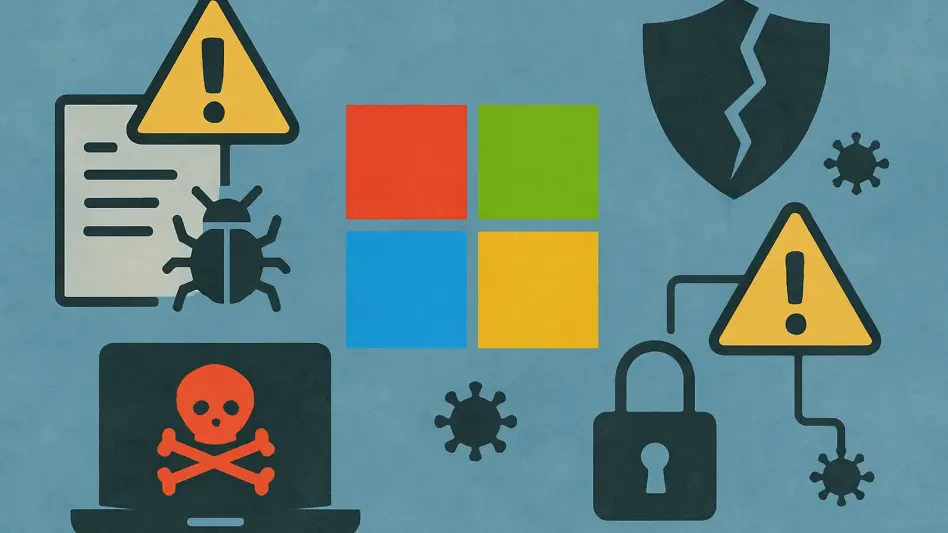In an era where cyber threats evolve at a relentless pace, Microsoft’s monthly Patch Tuesday updates remain a cornerstone of digital defense for organizations worldwide, and the August release stands as a stark reminder of the stakes involved. This month’s update addresses a staggering 107 vulnerabilities across a vast array of products, from Windows to Microsoft Office and Azure services, highlighting the persistent and pervasive nature of security risks in today’s interconnected systems. With 13 of these flaws classified as Critical and a publicly disclosed zero-day vulnerability demanding urgent attention, the update underscores Microsoft’s ongoing commitment to fortifying its ecosystem against sophisticated attacks. For IT and security professionals, this rollout is not just a routine task but a critical opportunity to safeguard sensitive data and infrastructure from potential exploits. The sheer volume and severity of the issues patched signal an ever-escalating battle against cybercriminals who target both foundational components and user-facing applications. Delving into the specifics of this update reveals not only the immediate threats but also broader trends shaping the cybersecurity landscape, offering vital insights for organizations aiming to stay ahead of malicious actors.
Unpacking the Scope of This Month’s Security Rollout
The breadth of Microsoft’s August security update is striking, with patches spanning a wide range of products and components integral to countless business operations. Windows bears the brunt of attention, receiving 67 patches to address vulnerabilities in its core systems, a clear indication of its centrality to both attackers and defenders in the cybersecurity arena. Extended Security Updates (ESU) account for 48 fixes, ensuring older systems remain protected, while Microsoft Office, a staple in productivity environments, sees 19 patches to mitigate risks in everyday tools. This distribution illustrates how vulnerabilities permeate both legacy and modern software, necessitating a comprehensive approach to patch management. Organizations managing diverse IT environments must prioritize these updates to prevent breaches that could exploit unpatched gaps, particularly in widely used platforms where the impact of a successful attack could be catastrophic.
Beyond the product-specific breakdown, the severity of the vulnerabilities adds another layer of urgency to this month’s release. Of the 107 flaws addressed, 13 are rated as Critical, meaning they pose a high risk of severe damage if exploited by malicious entities. A zero-day vulnerability, already known to the public, further heightens the stakes, as it represents an immediate threat that could be leveraged before many organizations have a chance to respond. The remaining 93 issues, though varying in impact, cannot be overlooked, as even less severe flaws can serve as entry points for broader attacks. This mix of critical and varied threats emphasizes the importance of a proactive stance, where timely application of patches becomes a non-negotiable defense mechanism for maintaining system integrity across diverse operational landscapes.
Recurring Threats and Vulnerability Patterns
A closer examination of the vulnerabilities patched this month reveals persistent patterns that continue to challenge cybersecurity efforts globally. Elevation of privilege flaws stand out prominently, with 42 patches addressing this category, which constitutes 39% of the total fixes. These vulnerabilities, also a significant focus in the prior month’s update, enable attackers to gain unauthorized access to higher levels of system control, potentially compromising entire networks. Such recurring issues suggest that attackers consistently target privilege escalation as a means to maximize damage, making it imperative for organizations to monitor access controls rigorously. Staying ahead of this threat requires not only applying patches but also enforcing strict privilege management policies to limit the blast radius of a potential breach.
Another dominant theme is the prevalence of remote code execution (RCE) vulnerabilities, with 35 patches tackling these high-risk flaws, accounting for 33% of the total. RCE issues are particularly dangerous because they allow attackers to execute malicious code without needing physical or direct access to a system, often leading to full system compromise. Additionally, information disclosure vulnerabilities, covered by 16 patches (15% of the total), pose a subtler but equally concerning risk by exposing sensitive data that could facilitate further attacks. These categories collectively paint a picture of a multifaceted threat landscape where attackers employ diverse tactics to infiltrate systems, underscoring the need for robust, multi-layered defenses that go beyond simple updates to include monitoring and rapid response capabilities.
Critical Flaws Demanding Immediate Action
Among the numerous vulnerabilities addressed, a zero-day flaw in Windows Kerberos, identified as CVE-2025-53779, emerges as a particularly pressing concern for security teams. Rated as Moderate with a CVSS score of 7.2, this elevation of privilege issue allows attackers who already possess high privileges to escalate further to domain administrator levels, posing a substantial risk to Windows domain environments. With exploit code already publicly available, even in the absence of active exploitation, the potential for severe impact on confidentiality, integrity, and availability looms large. Organizations are strongly advised to apply Microsoft’s official fix without delay to mitigate risks, especially in environments where attackers might already hold elevated access, as the consequences of inaction could be devastating to network security.
Equally alarming are several critical remote code execution vulnerabilities that carry exceptionally high CVSS scores, indicating their potential for catastrophic damage. Notably, CVE-2025-50165 in the Windows Graphics Component, with a score of 9.8, enables unauthenticated attackers to execute arbitrary code through flawed decoding of JPEG images in Office documents or third-party files. Similarly, CVE-2025-53766 in GDI+, also scoring 9.8, allows RCE via a heap-based buffer overflow triggered by specially crafted metafiles in documents or web services. Both flaws can be exploited without user interaction, amplifying their threat level. Microsoft Office itself harbors four critical RCE vulnerabilities, each with a CVSS score of 8.4, exploitable locally through mechanisms like the Preview Pane, demonstrating how everyday tools can become dangerous attack vectors if not promptly updated.
Elevation of Privilege and Cloud Environment Risks
A critical elevation of privilege vulnerability in Windows NTLM, cataloged as CVE-2025-53778, warrants significant attention due to its potential impact, reflected in a CVSS score of 8.8. This flaw could enable low-privileged attackers to gain SYSTEM privileges through an authentication bypass over a network, creating a pathway to full system control. Although there is no evidence of active exploitation or public disclosure at this time, its nature makes it a likely target for future attacks, as authentication flaws are often prioritized by malicious actors. Swift application of the provided patch is crucial to prevent such vulnerabilities from being weaponized, and organizations must reinforce their authentication protocols to reduce the likelihood of successful exploitation in the interim.
Turning to cloud environments, the Azure ecosystem also faces critical vulnerabilities that highlight the complexities of securing modern infrastructure. Issues such as CVE-2025-49707, a spoofing flaw with a CVSS score of 7.9, alongside other information disclosure vulnerabilities affecting Azure Virtual Machines and Azure Stack Hub, reveal risks ranging from identity spoofing to sensitive data exposure. While many of these flaws have been mitigated at the service level by Microsoft, requiring minimal customer intervention, their presence serves as a reminder of the shared responsibility model in cloud security. Organizations leveraging Azure services must stay informed about such risks and ensure their configurations align with best practices to prevent potential breaches, even when direct patching isn’t required on their end.
Wider Implications for Cybersecurity Strategies
The August security update offers a window into broader cybersecurity trends that continue to shape the threat landscape for organizations of all sizes. The dominance of elevation of privilege and remote code execution vulnerabilities suggests that attackers remain focused on gaining control over systems or executing malicious code remotely, exploiting both systemic weaknesses and user interactions. This persistent focus on high-impact flaws indicates a need for constant vigilance, as even a single unpatched vulnerability can serve as a gateway to widespread disruption. Timely patching, as emphasized by this update, remains an essential pillar of defense, particularly for publicly disclosed issues like the Windows Kerberos zero-day, where the window for exploitation may already be open.
Moreover, the diversity of attack vectors—from file processing exploits involving JPEG images and metafiles to network-based attacks—signals that relying solely on patches is insufficient for comprehensive protection. A multi-layered security strategy that incorporates strict access controls, continuous monitoring for suspicious activity, and rapid incident response capabilities is vital to counter these varied threats. With the end of support for Windows 10 approaching in October, organizations face an additional imperative to upgrade to supported operating systems to ensure they continue receiving critical security updates. Planning for this transition now can prevent future vulnerabilities from becoming unmitigated risks, reinforcing the importance of forward-thinking cybersecurity planning in an era of relentless digital threats.
Reflecting on Actions and Future Preparedness
Looking back, the August security update from Microsoft marked a significant effort to address 107 vulnerabilities, including 13 Critical flaws and a high-profile zero-day issue, across a spectrum of products like Windows, Office, and Azure. The focus on elevation of privilege, remote code execution, and information disclosure risks painted a vivid picture of the challenges faced by security teams in combating sophisticated cyber threats. Each patch applied represented a step toward safeguarding critical infrastructure from potential exploits that could have led to data breaches or system compromises. The urgency surrounding publicly known flaws and high-severity issues served as a stark reminder of the speed required in modern cybersecurity responses.
Moving forward, organizations must translate the lessons from this update into actionable strategies for resilience. Prioritizing patch management as part of a broader cybersecurity framework, rather than a standalone task, can help address both immediate and emerging threats. Investing in tools for vulnerability prioritization and risk assessment will streamline the process of identifying and mitigating critical flaws. Additionally, preparing for milestones like the end of Windows 10 support through timely system upgrades ensures long-term protection. By adopting a proactive stance—layering defenses with robust monitoring and access controls—businesses can better navigate the evolving threat landscape, turning the insights gained from this month’s update into a foundation for enduring security.








